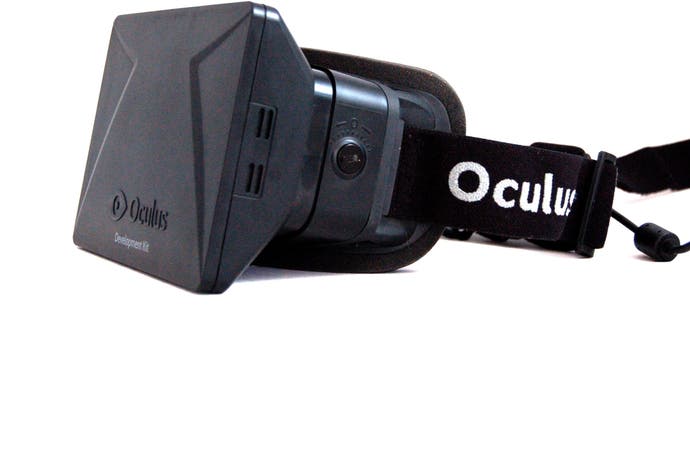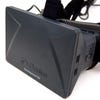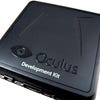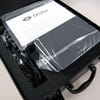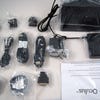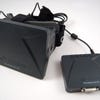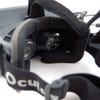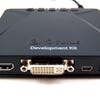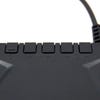Digital Foundry: Hands-on with Oculus Rift
Luckey strike.
Now we get it. Now we know why the media is so excited by the next generation of virtual reality, and beguiled by Palmer Luckey's Oculus Rift head-mounted display in particular. Don a ready-calibrated unit, dive into a specially prepared demo and the next ten minutes of your life could well redefine your expectations of the next era of gaming.
The Rift isn't perfect - resolution in particular is a genuine issue - but at its best, it offers true immersion on a level you've never experienced before, and the sheer potential offered by the system is simply irresistible. After your first experience in the Rift, every first-person perspective game you play from then on will be couched in terms of how it would "feel" played in VR. By moving beyond the flat, 2D confines of current display technology, the Oculus headset does indeed go some way to living up to its billing, of allowing players to "step into the game". But beyond the media demos, does the experience actually hold up for extended play? Is VR truly a viable new way to experience gaming?
Thousands of gamers obviously hope so. Oculus Rift caught the imagination of Kickstarter backers like no other piece of hardware before, raising $2.4m from 9522 contributors, around 7000 of whom laid down over $300 in order to get their hands on pre-release development hardware - not bad when Rift creator Palmer Luckey was aiming for a mere $250,000 in crowd-funded investment. In the days before and after the Kickstarter appeal, Luckey surrounded himself with a high-profile team looking to bring the Rift to market, attracting a further $2.5m of investment funds. The results of that investment are finally starting to appear in the form of complete development kits, now in the process of shipping to all Kickstarter backers. A thousand Rifts were rushed to the UK via DHL last week (Oculus is now in the process of setting up a proper UK fulfilment centre), and Digital Foundry's unit was one of them.
Once freed from its carton, the Rift package itself is genuinely impressive - a world away from the gaffer-taped assemblage of components first seen in the now legendary John Carmack demos. The imposing, robust plastic travel case houses the head-mounted display itself, its break-out box, and a multi-voltage power supply with exchangeable plugs that should allow the Rift to operate almost anywhere in the world. USB, DVI and HDMI cables are included (there's even an HDMI to DVI adaptor), along with two additional sets of lenses, making for three in total. Everything has its place in the Rift carry-case, with separate compartments cut into the foam insert for all major components. The overall impression you take away from the package is that it could take some severe punishment without the precious equipment inside taking any damage.
The Rift itself is made from durable plastic, with a heavy duty adjustable fabric headband that keeps the HMD securely in place, and a foam insert to protect your face from the harsh materials of the headset. Inside the visor we find two lenses designed to warp the LCD imagery around your eyeballs, convincingly simulating peripheral vision in supported games. Twisting these lenses loosens them from the sockets, allowing them to be easily replaced with alternatives for those with less than perfect vision. However, we'd recommend that wearers of glasses try to use them in concert with the standard lenses, or even switch to contacts. The optional lenses are OK, but Oculus can't be expected to provide optics to match everyone's individual prescriptions.
Once the HMD is in place, it's quite remarkable just how light and comfortable it is - especially if you've used the larger, more cumbersome Sony HMZ-T1 3D viewer in the past. Yes, remarkably, Palmer Luckey's start-up outfit has managed to create a more comfortable 3D viewer than Sony - on its first attempt.
Motion sensors are housed behind the screen in the Rift itself, with a single cable snaking out of the HMD, in turn leading to the Oculus break-out box. Here we see HDMI and DVI inputs, along with a 5v power socket and a standard USB connection to your PC. The Rift uses existing USB HID protocols, like those used for keyboards and mice, so you don't even need to install a driver to get it up and running. Ideally you should set up the PC to output the 1280x800 native resolution of the Rift itself, but you can feed it higher 16:10 resolutions, as the break-out box downscales nicely (but expect a little additional latency for doing so). It's also worth cloning the output of your GPU to a secondary monitor so you can keep track of what's going on when your PC isn't displaying a VR output. We'd recommend setting the Rift as the primary display though - GPUs tend to lock to the v-sync of the first screen, and as display refreshes rarely match, sometimes you're left with screen-tear on the other - far better to have that on your monitor than on the Rift output.
Team Fortress 2: the VR experience
While there's no Doom 3: BFG Edition support for the Rift after all, there's still one title out there with full Rift support: Valve's Team Fortress 2. Adding a "-vr" suffix to the launch command line kicks in the stereo output, and there's a wealth of developer console commands to work with, including a bespoke VR calibration mode that adjusts the 3D effect. There's also a selection of eight different control methods.
This might sound like a big deal, but in reality they are all variations on the same theme; standard mouse-look is replaced with VR motion tracking, and the options are typically reserved for variations in how weapons are aimed, and to what extent they are "unlocked" from mouse-look/head-tracking. The default option is the best - the target reticule stays on-screen at all times (so effectively, the view weapon tracks towards where you are looking) but the mouse itself is used to point your gun wherever you want within your line of sight. Dragging the mouse beyond that overrides the tracking, so mouse-look still works in a conventional manner to a certain extent.
It's easy to use, it's intuitive, but it's not going to make you a better player - it's simply a neat application of VR and more fully immerses you into the environment. It's compelling to use the head-tracking to look around, and even to look at your own character model more closely, but actual gameplay applications turn out to be rather limited. It's just... well, cool. What you do get is a decent workout for the technology itself though - environments now have genuine scale and field of view is immense enough that you have genuine peripheral vision. Perhaps the most impressive element is the implementation of stereoscopic 3D - everything just works and looks natural, with very little of the "diorama" effect we've previously seen on 3DTVs, where objects are arranged by depth but don't seem to have actual depth themselves. Particles in particular, from gunfire to ricochets to debris, simply look wonderful.
But outside of Oculus's demos, the limitations of the system come sharply into focus - literally. The Rift utilises the same 7-inch 1280x800 screen found in the Google Nexus 7 tablet, but claims of 640x800 resolution per eye need to be put into context. That may well be what is being rendered internally, but once the image is warped and sent out to the Rift, effective resolution is being lowered already, and an additional degree of that detail level is used to render your peripheral vision - so the actual amount of real estate dedicated to your main gameplay view is very, very low. Here's a screenshot with a rough estimate of how much detail is actually being resolved in your main line of sight when peering through the visor.
The effect is somewhat akin to playing games standing in front of a stadium Jumbotron - pixels are colossal, and resolution is low to the point where almost all of the text in Team Fortress 2 is completely unreadable. As a consequence, there is clear and obvious motion blur from the LCD too, though this was less of an issue than we thought it would be.
Oculus is looking to implement a 1080p screen for the consumer unit (Oculus COO Laird Malamed told us that the 5-inch screen in the Samsung Galaxy S4 is well-liked by Palmer Luckey), and while this will clearly help a great deal, a 2x increase in resolution is still going to look nowhere near as detailed as standard HDTV image. Even with a higher resolution display, we're still going to be looking at comparatively huge pixels and perhaps something approaching a perceptual 480p image.
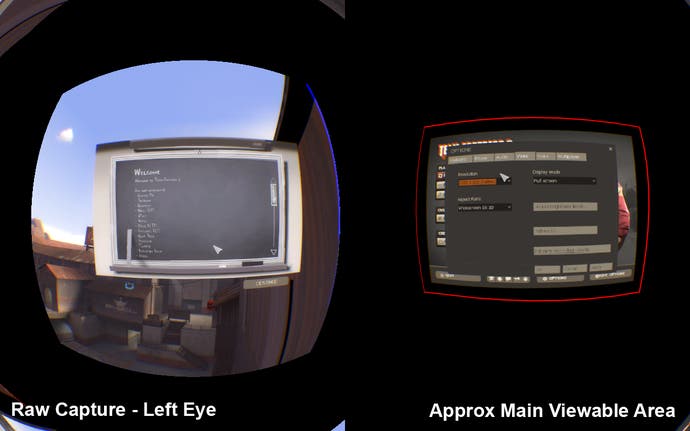
The next challenge is entirely personal to each individual gamer. Even with careful display calibration, your first foray into the world of VR gaming is likely to end within 10-15 minutes by an increasing feeling of nausea, scaling up to the point where you really need to remove the HMD. You can't really call it motion sickness, because you're not moving, but the point is that you think you are, with the disconnect building to the point where users genuinely don't feel very well. Perhaps you'll be tempted to dismiss this as something that only happens to other people, but it's worth pointing out that this reporter has been gaming for 33 years with no ill effects - until Oculus Rift came along. The virtual reality effect is so profound and overwhelming that you'll need time to adjust; Oculus itself refers to it as a case of "finding your VR legs" and says that you acclimatise over time, but in the short-term, you should stick to 10-minute bouts of gaming followed by a break. Really.
The Hawken demo
Currently unavailable to Rift owners, we were fortunate enough to get some hands-on time with the GDC Hawken demo in a private Oculus demonstration earlier this week. The demo itself isn't particularly compelling in terms of the gameplay - it's a simple mech-based bot match and nothing more - but the VR experience is intriguing on a number of levels.
First of all, there's the sensation of being inside the mech itself - motion tracking allows you to look around the interior of the cockpit, and get a closer look at your arm-mounted machine guns and rocket launchers just by turning your head and looking at them. What's curious here is that we're seeing a very proper approach to 3D to the point where you need to adjust your focus to concentrate on what's close to you, with the main view naturally blurring - an actual, natural depth-of-field effect, if you like. Also interesting is that you get a genuine sense of height to the mech cabin as you stomp around the cityscape, which you don't really "feel" to anything like the same degree in the normal 2D mode.

Perhaps the most impressive sensation of all is the sheer height of the environments. The Oculus demo has debug mode enabled, allowing your mech to boost up into the sky with no limits. Hopping from rooftop to rooftop is interesting enough and plenty of fun, but there's an eerily convincing sense of vertigo as you look down on the ground far below, and a genuine mini-rush as you leap over the edge and plummet down to terra firma. Good stuff.
On a more mundane technical level, another key takeaway from this demo is the need for high-end anti-aliasing. Here, it wasn't enabled to any great degree, giving an ultra-jaggy element to edges that wasn't particularly pleasing to the eye - a side-effect of the giant pixels. Team Fortress 2 supports up to 16x CSAA on Nvidia hardware and it made a big, big difference to the overall quality of the presentation.
Skyrim, Half-Life 2, Mirror's Edge and more - the third party hacks
You've probably seen a bunch of "see Game X running on Oculus Rift" news stories floating about recently, where fan favourites have Rift functionality grafted on via the Vireio Perception open source 3D driver. In essence, it's a Direct3D override hack that performs the necessary 3D separation and perspective warping to introduce Rift functionality into existing games. Initial versions of the hack didn't support the Rift's internal motion sensor, but recent betas have addressed that, allowing for something approaching full functionality - albeit with some limitations. Take Half-Life 2 for example - head-tracking is tied entirely to mouse-look, so there's no separation of the weapon from where you're looking - it's at this point where you can begin to appreciate the amount of work that's gone into the various Team Fortress 2 control implementations.
Because the Vireio driver is essentially hooking its way into DirectX, it isn't always as effective as you might hope; for example, Skyrim's shadows have no stereo effect meaning you need to turn them off in order to preserve the integrity of the 3D image. Field of view often needs to be adjusted via console commands or .ini hacks in order to get something approaching a decent image. Interfaces and HUDs are also a problem, and it's not just about text size either - standard form is to move these elements into the corners of the screen on a conventional 2D screen. On the Rift, this transplants them deep into your peripheral vision, making them impossible to use. On top of that there are still some frustrating calibration issues (an in-built tool is supplied, but we had mixed fortunes with it) and it requires some degree of work to get good results.
Generally speaking, games using the Source engine (Left 4 Dead, Dear Esther, Half-Life 2) appear to work rather well, while almost every other game had issues that detracted from the experience to varying degrees. However, bearing in mind that we're just a few weeks away from launch, the amount of progress that the open source community has made here is frankly superb.
The good news is that it all comes with the blessing of Oculus VR itself. Palmer Luckey's vision was always to get the hardware out there and then watch what the community does with it - similar to the way that Kinect was embraced so enthusiastically (albeit fleetingly) by legions of enthusiasts. Oculus calls this phenomenon "crowd-lifting" and the thinking behind it is remarkably straightforward: the more concepts and "hacks" that become available, the more exposure the Rift gets, and the more likely it is to become a genuine success story once it's released to retail.
Oculus Rift Developer Kit - the Digital Foundry verdict
Oculus VR has been completely up front and honest about this product: it's a developer kit aimed at games makers, it's not representative of the final consumer device, and it will be significantly improved for its true "gen one" retail release. But at the same time, the media frenzy surrounding the Rift has clearly brought about plenty of buy-in from gamers who want to experience this new frontier in gameplay as soon as possible. With games available now and the Rift still available for pre-order on the Oculus VR website to anyone who wants one, the question is whether the current hardware is worth its $300 asking price. In truth, we would have to say that the answer is no - certainly right now, it's just too early.
That's not to say that the Rift isn't a cool piece of kit, because it's a landmark achievement. It's forerunner hardware that represents a new way to play games - offering up a genuine IMAX sense of "being there" in the game world that we've never experienced before. The low-latency head-tracking is key to its success. It could be improved but even in its current state, it's ready for show-time. Stereo 3D - something which developers have grappled with for years now - just works without feeling forced or unnatural, an achievement that's all too easy to ignore. But for all the Rift's successes, you can't escape the fact that this is prototype hardware in need of major software support - not to mention hardware upgrades that will most likely render the current model obsolete.
What's missing right now won't come as any kind of surprise to the Oculus team. We really need a device-level calibration tool that's quick and easy to use, that persists across games with support for saved presets for different players. Proper calibration is essential for lessening the inevitable nausea and getting your "VR legs" - dealing with it right now is a time-consuming, often frustrating experience. The tracking works well as far as it goes but there's a glaring omission: the world is so immersive you want to peer more closely at things, but you can't. When you're startled and you jerk your head back, you want that to be represented in-game but it isn't - the takeaway here is that we need an additional dimension to the tracking to complete the package.
"The Rift is just the beginning of the VR journey. The next big challenge is a new control interface worthy of the immersion Oculus' technology provides."
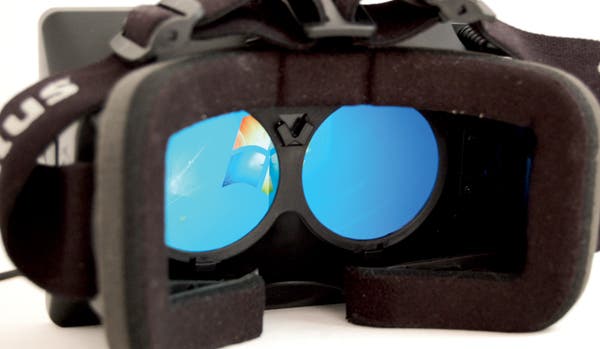
But, obviously, it's the resolution that's the real deal-breaker. 640x800 per eye might sound like a reasonable amount of resolution on paper, but the impression you get while gaming is something much, much lower, meaning giant pixels and very poor resolution. Oculus wants to shift to a 1080p screen for its consumer product, but based on the results from this 1280x800 display, even a 2x boost in pixel depth will probably still look noticeably rougher than a current-gen console game.
The Oculus team knows all of this, of course, and you can be sure that there will be solutions to most of these issues in the initial consumer product, but even then, there are larger, more fundamental challenges on the horizon. Developers need to figure out what they actually want to achieve with this technology: while replacing mouse-look with head-tracking is extremely cool, the novelty does wear off quite quickly. A new way of gaming requires an innovative approach that really puts VR through its paces, and we're unsure to what extent grafting on support to existing games will work: long-time Team Fortress 2 players who try out the Rift will doubtless move back to their 2D monitors before too long because as fun as it is, the game mechanics simply work better that way.
Our other concern is one of control. Oculus Rift offers the potential for complete gaming immersion, but what it doesn't offer is any way to better interact with the world it so vividly brings to life. Mouse, keyboard, and even joypad - these are control interfaces designed for another era, keeping you one or two stages removed from the world you are immersed in, leading to an oddly detached experience. You want to reach out and touch things, and interact in a more intuitive manner - but you can't. So what's the future here - Leap Motion finger tracking? Some kind of PlayStation Move-style controller? Minority Report gloves? The truth is that we don't know, we're in uncharted territory and right now we have no idea how it will evolve. For all its drawbacks, the Rift makes a powerful statement about the future of virtual reality, but even with the dev kit's major issues addressed, we're still a long, long way off from an experience that lives up to the raw potential.
